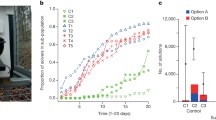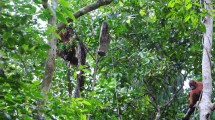Abstract
Innovation and social learning are the raw materials for traditions and culture. Of these two, innovation has received far less scrutiny, largely because of difficulties assessing the innovation status of behaviors. A recent attempt proposes recognition of innovations in natural populations based on assessment of the behavior’s properties and its geographic and local prevalence. Here we examine the validity of this approach and the list of 43 potential innovations it generated for wild orangutans by extending the comparison to zoo orangutans. First, we created an inventory of the behavioral repertoire in the zoo population. Four of ten putative innovations recognized in the field and potentially present in captivity did not occur despite appropriate conditions, suggesting they are indeed innovations. Second, we experimentally produced relevant conditions to evaluate whether another five potential innovations could be elicited. Based on their continued absence or on their latencies relative to known behaviors, four of the potential innovations could be assessed as innovations and one as a modification. Because 53% of relevant innovations recognized in the field could be confirmed in this analysis, and another 27% assigned possible innovation status, we conclude that the geographic method for detecting innovation in the wild is valid. However, the experiments also yielded up to 13 additional innovations, suggesting that zoo orangutans are far more innovative than wild ones. We discuss the implications of this latter finding with regard to limiting factors for the expansion of cultural repertoires in wild orangutans.





Similar content being viewed by others
References
Altmann J (1974) Observational study of behaviour: sampling methods. Behaviour 49:227–267
Boogert NJ, Reader SM, Hoppitt W, Laland KN (2008) The origin and spread of innovations in starlings. Anim Behav 75:1509–1518
Bouchard J, Goodyer W, Lefebvre L (2007) Social learning and innovation are positively correlated in pigeons (Columba livia). Anim Cogn 10:259–266
Box HO, Gibson KR (1999) Mammalian social learning: comparative and ecological perspectives. Cambridge University Press, Cambridge
Caldwell CA, Whiten A (2006) Social learning in monkeys and apes: cultural animals? In: Campell CJ, Fuentes A, MacKinnon KC, Panger M, Bearder SK (eds) Primates in perspective. Oxford University Press, Oxford, pp 652–664
Call J, Tomasello M (1996) The effect of humans on the cognitive development of apes. In: Russon AE, Bard KA, Parker ST (eds) Reaching into thought. Cambridge University Press, New York, pp 371–403
Day RL, Coe RL, Kendal JR, Laland KN (2003) Neophilia, innovation and social learning: a study of intergeneric differences in callitrichid monkeys. Anim Behav 65:559–571
de Waal FBM (2001) The ape and the sushi master: cultural reflections of a primatologist. Basic Books, New York
DMK (2006) Formeln und Tafeln, 11th edn. Orell Füssli, Zürich
Fox EA, van Schaik CP, Sitompul A, Wright DN (2004) Intra- and interpopulational differences in orangutan (Pongo pygmaeus) activity and diet: implications for the invention of tool use. Am J Phys Anthropol 125:162–174
Fragaszy DM, Perry S (2003) The biology of traditions: models and evidence. Cambridge University Press, Cambridge
Galef BG, Giraldeau LA (2001) Social influences on foraging in vertebrates: causal mechanisms and adaptive functions. Anim Behav 61:3–15
Gruber T, Muller MN, Strimling P, Wrangham RW, Zuberbühler K (2009) Wild chimpanzees rely on cultural knowledge to solve an experimental honey acquisition task. Curr Biol 19:1–5
Halsey LG, Bezerra BM, Souto AS (2006) Can wild common marmosets (Callithrix jacchus) solve the parallel strings task? Anim Cogn 9:229–233
Heyes CM, Galef BG (1996) Social learning in animals: the roots of culture. Academic Press, London
Jaeggi AV, Dunkel LP, van Noordwijk MA, Wich SA, Sura AAL, van Schaik CP (2009) Social learning of diet and foraging skills by wild immature Bornean orangutans: implications for culture. Am J Primatol 71:1–10
Jantschke F (1972) Orang-Utans in Zoologischen Gärten. R. Riper & Co. Verlag, München
Kawai M (1965) Newly-acquired pre-cultural behavior of the natural troop of Japanese monkeys on Koshima islet. Primates 6:1–30
Kendal RL, Coe RL, Laland KN (2005) Age differences in neophilia, exploration, and innovation in family groups of callitrichid monkeys. Am J Primatol 66:167–188
Kummer H (1971) Primate societies: group techniques of ecological adaptation. AHM Publ. Corp, Arlington Heights
Kummer H (1992) Weisse Affen am Roten Meer: Das soziale Leben der Wüstenpaviane. Piper, München
Kummer H (1995) In quest of the sacred baboon: a scientist’s journey. Princeton University Press, Princeton
Kummer H, Goodall J (1985) Conditions of innovative behaviour in primates. Philos Trans Royal Soc Lond Ser B Biol Sci 308:203–214
Kummer H, Kurt F (1965) A comparison of social behaviour in captive and wild hamadryas baboons. In: Vagtborg H (ed) The baboon in medical research. University of Texas Press, Austin, pp 1–46
Laland KN (2004) Social learning strategies. Learn Behav 32:4–14
Lefebvre L, Reader SM, Sol D (2004) Brains, innovations and evolution in birds and primates. Brain Behav Evol 63:233–246
McGrew WC (1998) Culture in nonhuman primates? Ann Rev Anthropol 27:301–328
Menzel EW (1968) Responsiveness to objects in free-ranging Japanese monkeys. Behaviour 26:130–150
Morand-Ferron J, Lefebvre L, Reader SM, Sol D, Elvin S (2004) Dunking behaviour in Carib grackles. Anim Behav 68:1267–1274
Morrison JA, Menzel EW (1972) Adaptation of a free-ranging rhesus-monkey group to division and transplantation. Wildl Monogr 31:6–78
Nishida T, Matsusaka T, McGrew WC (2009) Emergence, propagation or disappearance of novel behavioral patterns in the habituated chimpanzees of Mahale: a review. Primates 50:23–36
Page EB (1963) Ordered hypotheses for multiple treatments––a significance test for linear ranks. J Am Statist Assoc 58:216–230
Ramsey G, Bastian ML, Van Schaik C (2007) Animal innovation defined and operationalized. Behav Brain Sci 30:393–437
Reader SM, Laland KN (2002) Social intelligence, innovation, and enhanced brain size in primates. Proc Natl Acad Sci USA 99:4436–4441
Reader SM, Laland KN (2003) Animal innovation. Oxford University Press, Oxford
Rendell L, Whitehead H (2001) Culture in whales and dolphins. Behav Brain Sci 24:309–382
Rijksen HD (1978) A field study on Sumatran Orangutans (Pongo pygmaeus abelii Lesson 1872). Ecology behaviour and conservation. H. Veenman & Zonen BV, Wageningen
Russon AE, van Schaik CP, Kuncoro P, Ferisa A, Handayani DP, Van Noordwijk MA (2009) Innovations and intelligence in orangutans. In: Wich SA, Utami Atmoko SS, Mitra Setia T, van Schaik CP (eds) Orangutans: geographic variation in behavioral ecology and conservation. Oxford University Press, Oxford, pp 279–298
Sachs L (1999) Angewandte Statistik: Anwendung statistischer Methoden, 9th edn. Springer, Berlin, p 397 (664–668)
Sol D, Lefebvre L, Rodriguez-Teijeiro JD (2005) Brain size, innovative propensity and migratory behaviour in temperate Palaearctic birds. Proc R Soc B Biol Sci 272:1433–1441
Tomasello M, Call J (2004) The role of humans in the cognitive development of apes revisited. Anim Cogn 7:213–215
Tomasello M, Stahl D (2004) Sampling children’s spontaneous speech: how much is enough? J Child Lang 31:101–121
Tomasello M, Savage-Rumbaugh S, Kruger AC (1993) Imitative learning of actions on objects by children, chimpanzees, and enculturated chimpanzees. Child Dev 64:1688–1705
van Schaik CP, van Noordwijk MA, Wich SA (2006) Innovation in wild Bornean orangutans (Pongo pygmaeus wurmbii). Behaviour 143:839–876
Whiten A, van Schaik CP (2007) The evolution of animal ‘cultures’ and social intelligence. Philos Trans R Soc B Biol Sci 362:603–620
Whiten A, Horner I, Litchfield CA, Marshall-Pescini S (2004) How do apes ape? Learn Behav 32:36–52
Zweifel N (2008) Dietary differences between two orangutan populations in Central Kalimantan, Indonesia. Indications of individual and social learning. In: Anthropology. University of Zurich, Zurich
Acknowledgments
We thank Robert Zingg and Denise Nierentz from Zurich Zoo, and Maria van Noordwijk (for help with the raw data from Tuanan), Karin Isler, Tony Weingrill, Annie Bissonnette, Cyril Grüter and Beno Schoch. All procedures of the study were performed in accordance with Swiss laws, and with the guidelines of the Primate Society of Japan.
Author information
Authors and Affiliations
Corresponding author
Appendices
Appendix 1
See Table 4.
Appendix 2
See Table 5.
About this article
Cite this article
Lehner, S.R., Burkart, J.M. & van Schaik, C.P. An evaluation of the geographic method for recognizing innovations in nature, using zoo orangutans. Primates 51, 101–118 (2010). https://doi.org/10.1007/s10329-009-0184-8
Received:
Accepted:
Published:
Issue Date:
DOI: https://doi.org/10.1007/s10329-009-0184-8




